Andy Extance investigates the chemistry that has helped recreational drugs evade the law, and its consequences
‘Do you know how many micrograms it takes to make a caterpillar dance?’
This cryptic question – sounding like it’s from Alice in wonderland, but in fact deadly serious – is typical of the psychoactive substance developer known as Dr Zee. It relates to a scientific project that he worked on at an Israeli company in the early 2000s, seeking to control crop-eating pests. The researchers took inspiration from the invulnerability of the khat plant, whose leaves Israel’s Yemenite community chew as a legal stimulant. Why didn’t insects devour it too, they wondered?
Perhaps the psychoactive molecule cathinone might be responsible, Zee and his colleagues theorised. Rather than directly killing the pests that ate them, they thought cathinone might make them jittery, rendering them easy targets for predators. Therefore the researchers started hunting similar molecules that might do it better. ‘It was the first project in which I learned to take a molecule, draw out the “analogue space”, figure out which ones we could make and try in field trials,’ he tells Chemistry World. Yet Zee also knew that the small chemical modifications that produced cathinone analogues might encourage more than just caterpillars to dance.

Having enjoyed chewing khat leaves himself, Zee developed a large-scale method to produce cathinone, making 700kg. He sold it legally for human use in capsules in Israel from around 2003 under the name ‘Hagigat’, which people compared to cocaine, noting its sexually stimulating effects. In 2004 the Israeli government banned it, but by that time Zee’s work on pest control had given him new ideas.
Seeing an opportunity in the new cathinone analogues he’d been helping devise, Zee started testing them on himself. While initially nervous, he followed carefully in the footsteps of Alexander Shulgin, the ‘psychonaut’ scientist who popularised the drug ecstasy, in ascending the logarithmic scale. Zee tested compounds by first taking around 10µg, then waiting a few days for it to leave his system. He increased the dose tenfold at each step, stopping if at any point things felt wrong, and discarding compounds if they didn’t do anything at 100mg, a ten-thousand-fold increase.
It spread all over Europe… and I said ‘Oh my god, what have I done?’
Dr Zee
As with cathinone, once Zee had found a substance with enjoyable effects, he set about producing it in large scale and selling it for recreational use. This molecule – 4-methylmethcathinone – would spread far beyond Israel, making headlines under the name mephedrone. ‘Its production method was reverse engineered by Chinese labs,’ Zee recalls. ‘Then it spread all over Europe and people said “What have you done?” – and I said, “Oh my god, what have I done?”’
Mephedrone’s appearance in Europe coincided with the lowest purity of cocaine and ecstasy on record in 2008 and 2009, as measured by the UK National Crime Agency. Because there hadn’t yet been any reason to ban it, mephedrone was sold legally as ‘plant food’ thanks to its crop science roots – and rapidly became popular as a ‘legal high’. The media in the UK soon connected it to the deaths of four teenagers, Louis Wainwright, Nicholas Smith, Joslyne Cockburn and Gabrielle Price.
Mephedrone is just the tip of the iceberg. Over 560 originally legal highs have appeared since the mid-2000s, sending governments scrambling to react. In the UK, these new psychoactive substances (NPSs) have been completely prohibited by the Psychoactive Substance Act 2016. This follows less comprehensive bans that erected barriers to certain parts of the analogue space psychonauts like Zee explore with their chemistry skills. NPSs pose serious questions about the science – particularly the chemistry – and philosophy of drug control.
A web of spice
Researchers like University of Hertfordshire pharmaceutical chemist Amira Guirguis are responding. When mephedrone infiltrated the UK in 2008, Hertfordshire researchers tracked it – and found many other NPSs appearing. ‘The accelerated evolution of NPSs has been driven by organised crime groups and opportunistic entrepreneurs, and fuelled by free access, easy communication and open, anonymous and discreet trade over the internet,’ Guirguis says. The internet also contributed by helping ‘clandestine chemists’ access scientific literature and letting psychonauts share information in their search for better experiences through drug forums, she explains.
Beyond psychonauts’ interest, NPSs grew rapidly because they were adopted by people pleased not to be breaking the law. And even as some NPSs started to be banned, people who were subject to routine drug tests still took them as they couldn’t be detected. ‘It is extremely challenging to identify something when you don’t know what you are looking for,’ underlines Guirguis. ‘Therefore, we need to develop methods to enhance the identification and classification of these drugs.’
That need brought clinical chemist Roy Gerona to the University of California, San Francisco (UCSF) in 2009, intending to help US poison centres. Because such centres must choose from targeted tests for specific substances thought well-validated enough to stand up in a court of law, they usually can’t spot anything new. Gerona was developing a non-targeted analysis approach, just as mysterious substances started causing hospital admissions.
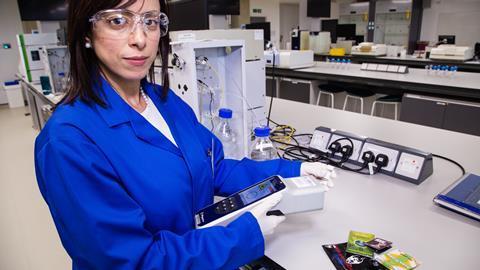
In 2010, his approach proved its worth with a patient exhibiting ‘bizarre behavior, suicidality and hallucinations’ after sniffing ‘bath salts’ in San Diego.1 Using liquid chromatography coupled with time-of-flight mass spectrometry (LC–TOF/MS) Gerona and colleagues found two synthetic cathinone analogues, methylenedioxypyrovalerone, and 4-fluoromethcathinone, known as flephedrone. His findings soon saw him recruited by the US Centres for Disease Control (CDC) and Drug Enforcement Administration (DEA) to investigate ‘mass intoxication events’, where NPSs harm many people.
‘By 2012, NPSs here in the US were in full swing,’ Gerona recalls, with mass intoxications caused by four different chemical classes. Today, Gerona specialises in synthetic cannabinoids (SCs), sold in products with names like Black Mamba and Pandora’s Box, commonly called spice in the UK and K2 in the US. The media has reported their shocking effects widely, including suddenheartattacks after very small doses.
One common issue is an increased burden on emergency services. For example, during a mass intoxication in Anchorage that Gerona investigated, SCs caused 10% of all call-outs from July 2015 to March 2016. Spice varieties containing 11 different SCs led to 1351 call-outs, involving 535 patients, and four deaths.
Then, in July 2016, a UCSF medical student noticed reports of an SC-related ‘zombie outbreak’ in Brooklyn: people groaning, moving sluggishly, answering questions slowly and staring blankly.2 Within four days, Gerona was testing blood and urine samples from those affected, but couldn’t find anything initially. ‘A lot of synthetic cannabinoids are metabolised very quickly,’ Gerona explains.
Luckily the police could provide samples of the substance they’d taken, sold as ‘AK-47 24 Karat Gold’, and Gerona’s team established it contained the SC AMB-FUBINACA. The team predicted how the users’ bodies broke this molecule down, and found the expected metabolite in all eight cases they had samples for. Among several similar zombie outbreaks, one in Manchester, UK, in April 2017 also involved AMB-FUBINACA , mixed with other SCs.
There are now more than a dozen different SC classes, with laboratories in China ‘constantly synthesising different types’, Gerona says. To understand how these molecules ran riot so spectacularly, it’s useful to return to one of their origins: the innocent curiosity of John Huffman at Clemson University in South Carolina, US.
Dose of bad news
Huffman’s work in the early 1990s built on the key psychoactive substances in the cannabis plant, δ9-tetrahydrocannabinol (THC) and cannabidiol.3 Like most drugs – medicinal or recreational – these molecules fit into and interact with receptor proteins in our cells like keys in locks. The shape of the cavity in the lock – the receptor – means that only certain keys – or drugs – fit.
Psychoactive drugs usually target receptors in nerve synapses, interfering with neurotransmitter molecules that influence our behaviour. They block or open receptor locks that control the release of neurotransmitters that in turn cause nerve signals. THC fits into two cannabinoid receptor types, CB1 and CB2. Our bodies naturally produce endocannabinoids, explains Jenny Wiley from RTI International in North Carolina, US, who has worked with Huffman on cannabinoid research. Endocannabinoids unlock CB1 and CB2 and reduce the release of another neurotransmitter to regulate appetite, pain, mood and memory.
Clandestine chemists are far ahead of research
Amira Guirguis, University of Hertfordshire
Scientists had discovered that CB1 receptors are responsible for THC’s psychoactivity, while drug developers had also devised SCs as potential painkillers. Huffman wanted to design molecules that might have medicinal effects through CB2, without unlocking CB1. His team made hundreds of molecules to explore the analogue space, and what they found has been pivotal in the spice explosion.
One important insight is that cannabinoid receptors are unusually easy to unlock, as many different types of molecule will fit into them. It’s therefore easy to find new SCs that avoid outlawed molecular structures. Another insight is that psychoactive drugs affect neurotransmitter release in a similar manner to how turning a tap controls water flow. Drugs that turn the tap part-way are known as partial agonists, whereas ones that turn it all the way open are full agonists.
SCs can be especially potent because they often have great affinity for both CB1 and CB2 receptors, Wiley says, which ‘usually translates to greater potency to produce intoxication’. ‘A user does not have to smoke as much of a SC to reach the same level of effect as they would if they were smoking cannabis,’ she says. ‘SCs also tend to activate the CB1 receptor to a greater extent than THC. Whereas THC is a partial agonist, SCs tend to be full agonists.’
One molecule Huffman’s team made, called JWH-018, binds four times as strongly to CB1 as THC does. It was therefore adopted by spice makers, becoming one of the first substances identified in then-legal highs.4 Consequently, although Huffman has retired, Wiley still studies the compounds to understand their adverse effects. For example, she has looked at how readily SCs make mice go into a rigid trance, known as catalepsy.5 Though this behaviour is ‘mediated by SC-induced activation of the CB1 receptor’, Wiley emphasises that we don’t know if it’s the same as what’s happening in the human ‘zombie outbreaks’.
Wiley and her colleagues also found that four SCs block a protein ion channel that controls calcium, sodium and potassium flow to keep our hearts beating. JWH-018 was the worst culprit for blocking it, and they say this could explain reported heart problems. ‘It is certainly possible that the sudden deaths reported with SCs could be related to cardiovascular events,’ Wiley observes, although it’s impossible to say for sure.
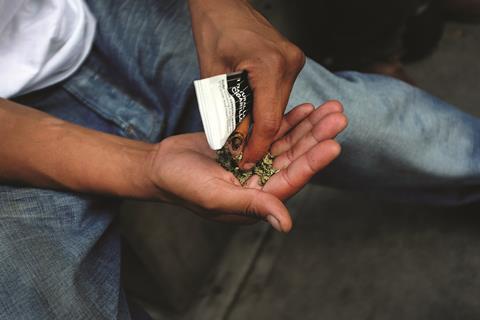
Media reports that suggest cannabis and SCs are similar by calling them ‘fake marijuana’ or ‘synthetic cannabis’ are doing ‘a huge disservice to readers’, Wiley adds. While many people do not think of cannabis as dangerous, SCs definitely are, she says. As well as the chemical difference between THC and SCs, cannabis also contains many other different compounds, with cannabidiol seeming to have a calming effect, for example. Spice does look similar to cannabis as it is usually supplied in a form that people can roll up and smoke. But to achieve this, one or more SC powders – without cannabidiol – is usually dissolved in a solvent like acetone and sprayed onto dried herbs.
While at first novelty and legality drove UK interest in NPSs, their illegality has dampened demand, says Fiona Measham, a criminologist at the University of Durham in the UK. Yet SCs’ potency means users have to take very little to get high, and can therefore do so very cheaply. This makes SCs the most obvious remnant defying the ban in the UK. ‘They attract people with low disposable income, people coming out of prison, living in hostels, homeless, unemployed and teenagers,’ she says.
Pharmacological cosh
The difficulty in detecting spice leads to it being taken by people being tested for drug use in prison, in rehabilitation, or on court-mandated drug treatment orders. It can readily be smuggled by soaking a piece of paper, like a letter, in an SC solution and letting it dry. Users then swallow or smoke the spice-soaked paper.
‘One real concern in prison is that the drugs can produce agitation, paranoia and violence,’ Measham says. ‘People are hospitalised, having very serious medical problems. Also, people are being spiked for non-payment of debts and other retaliation. It’s being used as a pharmacological cosh – and for entertainment. The sort of mannerisms people portray are seen as entertainment. The prisoners I speak to will say that spice is the number one drug problem in prison. None of them have a good word to say about it.’
So why do they use it? Part of the answer is that prisoners, like homeless people, are more likely to have psychological problems, explains Ian Hamilton, a mental health and addiction researcher at the University of York in the UK. ‘In my clinical experience it’s incredible that people survive as long as they do with quite serious mental health problems, but survive they do,’ he says. ‘Whether a drug’s legal or illegal, people migrate towards a substance that they feel has some benefit for them. I’ve met people with really quite florid psychosis who’ve survived for years on the streets. Quite often they use drugs to keep a lid on that.’ Even if prisoners might prefer to use cannabis to self-medicate, THC stays in the body longer so it’s easier to test for. Consequently, researchers have proposed reforming mandatory drug testing to reduce harm.6
Mental health isn’t the only reason people self-medicate – they often use spice to deal with ‘difficult social contexts’ like homelessness, says Lydia Davenport from the Bristol Drugs Project (BDP) in the UK. BDP deals with 2000 clients per year, with around half on opiates like heroin, and some homeless people taking heroin and crack have also started taking spice, she says. But Davenport goes on to explain that BDP sees two other main groups of NPS users, albeit small, who might be at university or have full-time jobs.
Whether a drug’s legal or illegal, people migrate towards a substance that they feel has some benefit for them
Ian Hamilton, University of York
The first group are men having sex with men, who use a cocktail involving typically γ-hydroxybutyrate (GHB) or γ-butyrolactone (GBL), mephedrone and crystal meth to facilitate long periods of intercourse, known as ‘chemsex’. The second group are psychonauts who, perhaps because they adopt the same cautious approach as Shulgin and Zee, usually only come to BDP in extreme circumstances.
‘The people we see tend to use several types of NPS and other drugs,’ Davenport explains. ‘It could be harming their mental health; they may be spending too much money, failing their university degree or getting in trouble at work. It might be that they have a dependency or they’ve got into trouble with one thing. A lot of our people taking a few NPSs get into the habit of taking one thing for an experience, another thing to perk them up, and another to get through exams. That really affects your mental health.’
The emergence of such substances inevitably forced official responses. Throughout the 2010s, the UK amended the Misuse of Drugs Act 1971, which makes supply and possession an offence and sets sentencing guidelines according to a drug’s classification. The government included mephedrone and cathinone as ‘class B’ drugs in 2010, some of the first among over 500 substances added. Then, it emulated Ireland and Poland in introducing legislation designed to control all psychoactive substances. The stated intention was to stop all retail sales, both online and in ‘head shops’ that sell smoking and drug-related products. But is it working?
Early wins
In the UK, production and supply of legal highs were banned on 26 May 2016. The Psychoactive Substances Act (PSA) 2016 instituted a blanket prohibition punishable by up to seven years’ imprisonment, with exemptions for medicines, food and drink, as well as caffeine, nicotine and alcohol. A main concern about the PSA is its broad scope. ‘A psychoactive effect is something which affects a person’s mental functioning or emotional state by stimulating or depressing their nervous system,’ states the government advice.
According to Simon Bray, the UK National Police Chiefs’ Council’s lead on NPSs, the PSA adds to the tools his colleagues had already been using for ‘enforcing against psychoactive substances’. In one operation, the UK’s North West Regional Crime unit shut down a website called ‘Wide Mouth Frogs’ that had earned around £3.8 million. When officers purchased their products in 2013, 77% of the items contained substances classified illegal by the Misuse of Drugs Act, including mephedrone.
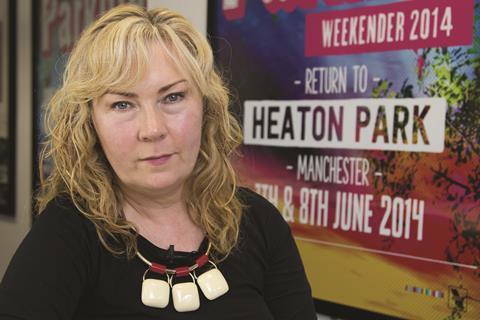
However, adding substances to the Misuse of Drugs Act requires recommendations from the UK government’s Advisory Council on the Misuse of Drugs (ACMD), whose membership includes both Measham and Bray. Under the PSA, police don’t need to wait for the ACMD. ‘You’ve got the option of enforcing if it suddenly starts to become a problem,’ Bray explains. ‘They’re not draconian powers, because there isn’t that possession offence, and there are limited powers of seizure and search. It’s mainly targeting overt sale. This cover-all approach also means that effectively you reduce the incentive for chemists to create new substances to get around the Misuse of Drugs Act.’
On December 29, 2016 the UK’s Home Office announced that using the PSA’s powers 332 shops had been stopped from selling psychoactive substances and 31 such ‘headshops’ had closed. Nearly 500 people had been arrested under the Act, and four jailed. Elle Wadsworth from King’s College London and her colleagues found that of 113 online shops that were selling NPSs in October 2015, only 52% remained in June 2016.7 Of UK-registered websites, less than a quarter were still active. In this regard, the PSA has been a success, Wadsworth says.
However Wadsworth questions whether closing down websites is the ultimate goal. ‘If the aim was to reduce the access and use of NPSs, then we cannot say that it has been a success,’ she says. ‘We have seen from research in Ireland that when they implemented their ban in 2010, use increased and NPSs were still accessible. The worry is that sales would simply move to other markets, such as street-level drug dealing or the cryptomarkets – underground markets without regulation.’
This recognition that drug prohibition victories are often short-lived is sometimes known as the ‘push down, pop up’ effect. It refers to how crackdowns on drugs in one place tend to shift the problem somewhere else. NPSs replay this game of whack-a-mole in the realm of chemistry. One reason ecstasy purity was low in 2007 and 2008 was due to mass seizures of the starting material safrole in Cambodia. Whacking that mole helped mephedrone’s rise to popularity. Prisoners adopting spice after their cannabis use was prohibited is another example.
Act in haste?
Among the main moles the authorities wanted the PSA to whack are three top UK NPS retailers, whose careers Measham has followed. Two have now left the trade – one of those considered himself a responsible NPS retailer, spraying SCs onto herbs so the final product’s potency was low. Now spice dealers have less motivation to care. ‘He said because the chemicals are so potent, people could very easily spray too much, and that has happened,’ Measham says.
NPS sellers who wanted to continue trading have popped up again, after relocating their websites to places like Spain, she adds. ‘They’ll import from China to Spain to the UK,’ Measham explains. There are too many packages for the UK’s Border Force to screen, she adds. Consequently, at the Bristol Drugs Project, Davenport says that while she has seen a lot less spice use since the PSA came in, clients aren’t generally bothered by drugs’ legal status. ‘Most people carried on buying at the rate they were already off the internet, especially the students,’ she explains. Similarly, she has seen little change in NPS prices, other than an increase for mephedrone.
‘We have to remember that the police is never planning to stop every drug getting into the country,’ responds Bray. ‘It’s not possible. So we have to focus on people who are supplying them, importing them, making them, or places where they cause the biggest misery, in open drug markets, through links with organised crime and physical harms.’
Nevertheless, the UK police has been working with postal services to get more options to detect small quantities of material, Bray adds. Other efforts include work between the EU and China, according to Bray, leading the Chinese government to introduce controls on hundreds of substances in 2013 and 2015. This has led to a definite reduction in the flow of substances coming into the UK from China, according to Bray.
Dr Zee has first-hand experience of how new laws have influenced the international NPS trade. He started looking at working with a Chinese supplier in 2015 on compounds that were later banned. ‘He said he didn’t care, and was arrested a month later.’ As a consequence of such moves, Zee says, all the cathinones have suddenly ‘faded away’, including some which are still ‘generally quite legal in most countries in Europe’.
Is it OK to take a drug to study longer and harder but not to dance for longer?
Fiona Measham, University of Durham
Zee himself is determined not to become a criminal because doing so means ‘fighting against forces that are way out of your league’. However, he says he has successfully fought cases with customs about his imports in Slovakia, the Czech Republic, Switzerland, the Netherlands, Spain and Portugal. ‘The law was on my side – or I was on the law’s side,’ he says.
The cycle of manufacturing and selling new psychoactive substances before they’re banned gives very little chance to collect safety data, Zee observes. However, the process is like a fast-forward version of how conventional industrial chemists explore structure–activity relationships, trying to design medicinal molecules by tweaking their structures. Zee notes that small changes in structure can create large changes in activity, which had tragic consequences in the case of one substance he had brought to market, 4,4’-DMAR.
Despite testing 4,4’-DMAR himself and with friends, it was soon blamed for 27 deaths in Hungary and the UK, so Zee promptly destroyed the rest of his stock. ‘I flushed $250,000 [£195,000] of material down the toilet,’ he confesses. Yet responding to such risks by pushing psychoactive substances into the criminal world drives sellers towards the strongest products, he adds. Faced with the risk of getting caught, they transport as little as possible.
Chemists like Guirguis have seen evidence for this: for the recently reported opiate NPS carfentanil, 100mg is sufficient to produce more than 10,000 doses, she says. And even tiny structural differences can also cause big detection challenges, especially with highly selective colour-changing immunoassays used by probation officers and in prison. With SCs in particular, changing a single atom in a structure can mean the result is ‘all clear’.

Chemical colour tests that are used for a wide range of drugs, for example using the Marquis reagent, have the opposite problem, Guirguis adds. A yellow colour might mean cathinone itself, or any slightly modified related substance.8 Worse still, UK seizures in 2014 showed that NPS mixtures contain up to six active ingredients. This is hard to disentangle, Guirguis says, and the individual NPS amounts are often so low they don’t show at all in some tests. Cutting agents or other adulterants can also mask the NPS signal when using handheld vibrational spectroscopy techniques.
Guirguis and her University of Hertfordshire colleagues have however been able to identify 29 out of 60 NPSs using a handheld Raman spectroscopy approach.9 Not only is this useful as a ‘first pass’ test, they also spotted similarities in the spectra for substances bought from different websites, suggesting similar supply chains. Yet because there is often no reference standard to compare entirely new substances against, developing such tests is difficult. Then, once standards are made, they’re normally very expensive to buy, and also require an expensive Home Office licence. ‘Clandestine chemists are far ahead of research,’ Guirguis admits.
But in San Francisco, Gerona and his colleagues are looking to seize back the advantage with what they call ‘synthetic prophetic libraries’.
Troublesome knowledge
Gerona’s team had grown impatient of waiting up to six months for commercial labs to make reference samples whenever it identified new NPSs. Gerona therefore started working with Sam Banister at nearby Stanford University. ‘Why can’t we pre-empt what these labs are going to synthesise?’ Gerona recalls thinking. Using the same kind of small changes from existing molecules that clandestine chemists might, Banister has made up to 150 potential SCs and metabolites for reference. However, the scientists are unsure whether to publish their results, in case NPS makers use them for inspiration.

This is ironic, Gerona says, because publishing their data would also be helpful to other clinical labs thanks to the method they use. LC–TOF/MS has a key advantage when studying unknown compounds in how it detects molecules’ masses, the UCSF scientist explains. The more common tandem mass spectrometry method relies on scientists knowing what they’re looking for. That’s partly because it can only distinguish differences between molecules greater than the mass of one hydrogen atom.
Gerona’s team’s quadrupole time-of-flight spectrometers record the mass of every molecule and the fragments of them that form in the instrument. They also detect differences as small as a thousandth of the mass of a hydrogen atom. ‘You can query your total ion chromatogram back again and again,’ Gerona adds. ‘I can look back at the samples I did in 2015, if in 2017 I realise the [drug labs] were synthesising a compound that I didn’t know about. I can’t do that in tandem MS.’
Dr Zee too has been forced to rethink his approach because of how rapidly new substances proliferate. ‘You invent a molecule, it’s copied, the commerce goes completely out of control very quickly, and then that market doesn’t exist any more,’ he says. Consequently, he is seeking patents to protect the benefits his inventions could bring in legitimate applications. One that he’s working on is using 3-methylmethcathinone in psychological therapy, for example in treating post-traumatic stress disorder.
Although Zee says NPSs earn him slightly over $150,000 a year on average, he maintains that he’s ‘not profit-driven’. ‘I do it because it’s difficult,’ he says. ‘I think that there can be a way for new compounds to be beneficial. You just have to define what that way is and stick to it, in terms of dosage and method of administration.’
Zee also acknowledges that for people to be free to take NPSs, their health effects must be understood. He argues that the UK government was able to pass the PSA because lack of knowledge about, and in turn fear of, the health risks undermined political resistance. If that fear did drive the PSA, it’s particularly unfortunate – because the early UK media stories connecting deaths to mephedrone were incorrect.
Out of proportion
Contrary to initial reports, Louis Wainwright, Nicholas Smith and Joslyne Cockburn died as a result of mixing heroin-replacement methadone with alcohol. Gabrielle Price died from an infection. It’s true that mephedrone has been connected to deaths – in 2015, 44 death certificates in the UK mentioned it, the highest year to date, despite government efforts. But there were 1201 deaths connected to heroin and morphine, 320 for cocaine and 157 for amphetamines. Just eight death certificates mentioned SCs, although that may be misleadingly low due to detection difficulties. These statistics give weight to what academics studying drug use suggest: that NPSs are attracting disproportionate attention – even after considering the spice burden on emergency services and prisons.
‘Banning the cathinones is pretty stupid really,’ comments Imperial College London neuropsychopharmacologist David Nutt, who was sacked from the ACMD after saying taking ecstasy is no more dangerous than horse riding. He argues that mephedrone’s arrival was beneficial. ‘Over the 10 years I was on the ACMD we had no impact on deaths from cocaine – in fact they went up,’ Nutt says. ‘Then mephedrone comes along, and cocaine deaths fall.’ Cocaine deaths in the UK hit a new high in 2015, which the country’s Office of National Statistics says could be partly due to recent increases in cocaine purity. However, Nutt asserts that the prior fall in deaths came because people switched to mephedrone, not because of cocaine’s lower purity at the time.
Nutt says that the cathinone ban is one of two primary examples of ‘how the law against recreational use has completely fouled up pharmaceutical research’. When the UK added cathinones to the list of substances covered by the Misuse of Drugs Act, it made a specific exemption for an antidepressant called bupropion, which is used to help stop smoking. However, research on any similar substances is held back by the need for Home Office licences, which Nutt says has ‘hammered’ addiction research. ‘There could well be analogues of bupropion that could be even more useful but because they’re now illegal, no one will work with them,’ he says. A similar situation has happened with analogues of ketamine, he adds, which is now also being explored as an antidepressant.
The law against recreational use has completely fouled up pharmaceutical research
David Nutt, Imperial College London
Broadening possession offences under the Misuse of Drugs Act to NPS structures, especially the many SC types, also affects pharmaceutical companies’ research libraries. For example, more of GlaxoSmithKline’s compounds are now covered, according to company spokesperson David Daley. However, he stresses that GlaxoSmithKline has the licences needed to continue work unaffected. His company is now working on the issue with the Association of the British Pharmaceutical Industry, other companies and academic institutions. ‘We’ve been talking to the government about potential barriers to research and how to minimise any impact from the regulations,’ he adds. ‘The ACMD is also exploring their impact on the conduct of legitimate research and we expect to hear from them later this year.’
The UK’s potentially research-constricting prohibition comes even though its citizens haven’t picked up on NPSs as much the US and Australia, according to Measham. She conducts drug use surveys at clubs and festivals very regularly, where she says she finds that people ‘like and want the traditional drugs’. ‘In the UK we have very easy availability of high-purity, low-price ecstasy, cocaine and ketamine. There’s no need for them to pursue substances that they don’t really know what the short-term effects or long-term consequences are.’
She calls the way the PSA bans substances regardless of harms or benefits ‘an absurdity’. ‘We’ve got a contradiction inherent within the act because it doesn’t couple criminalisation with any assessment of harm at all,’ she says. As part of the ACMD, she advised including a ‘safety valve clause’, where substances considered to cause very low harm are exempted from the act, which wasn’t adopted. ‘We were never going to eliminate drug use,’ she stresses. ‘If we’re not going to get drugs out of the picture, then we want to steer people towards less harmful substances.’
Measham suggests that the cause of the contradiction might be judgements about people taking drugs for pleasure. ‘For example, how do we feel about someone sitting in a room for eight hours and taking a psychedelic trip?’ she asks. ‘Is it OK to take a drug so you can study for longer and harder, but not OK to take it to go and dance longer and harder? This is very much an issue for us at the University of Durham, because our undergraduates are taking cognitive enhancers. We now keep our library open 24 hours a day, so arguably we’re facilitating this. The point being that we know that some of these are reasonably safe.’
Yet regulating according to the harmfulness of a substance is tricky too, as New Zealand has shown.
Legal questions
In July 2013, New Zealand passed its own PSA. Initially it aimed to establish a regulated market for ‘low risk’ recreational products, explains Marta Rychert, a drug law and policy researcher at Massey University in Palmerston North, New Zealand. ‘The mechanism for approving products is similar to medicines,’ Rychert says. ‘Sponsors get their products approved by a government agency, if they provide scientific evidence from clinical trials.’
When the New Zealand PSA was passed, a full regulatory testing framework was not in place. The government therefore allowed products for which there had been no significant reports about health harms to stay on the market. Then, the government amended the PSA in May 2014, withdrawing all interim product approvals following public protests, Rychert says. Consequently, as in the UK, all NPSs are banned. At the time of writing no evidence has been submitted for approval of any low-risk NPSs in New Zealand.
Meanwhile, the most commonly used illegal drug, cannabis, is increasingly being normalised. In the US, legal medical and even recreational use has gained pace countrywide. In March 2017, the Israeli cabinet approved a proposal to decriminalise cannabis use. This follows the Netherlands’ example, where cannabis cafés are credited with contributing to lower levels of drug use among young people by keeping them away from criminals. In 2001, Portugal followed a similar path, relaxing enforcement and penalties to fight a major heroin problem in a strategy that has halved the number of users of all drugs.
The UK isn’t currently likely to follow these examples, with its recently-published Drug strategy 2017, mostly building on existing criminal justice and recovery measures. ‘This Government has no plans to decriminalise drugs,’ a Home Office spokesperson tells Chemistry World. ‘Our approach on drugs remains clear – we must prevent drug use in our communities, support people through treatment and recovery, and tackle the supply of illegal drugs. It is overly simplistic to say that decriminalisation works. Historical patterns of drug use, cultural attitudes, and the policy and operational responses to drug misuse in a country will all affect levels of use and harm. Also, different countries have different means of collecting data, so it is often difficult to directly compare.’
Of course, there is a legal drug, which was linked to 8758 deaths in the UK in 2015: alcohol. And while spice zombie outbreaks seem stark, they’re not so very different from scenes of people staggering around and collapsing while extremely drunk.
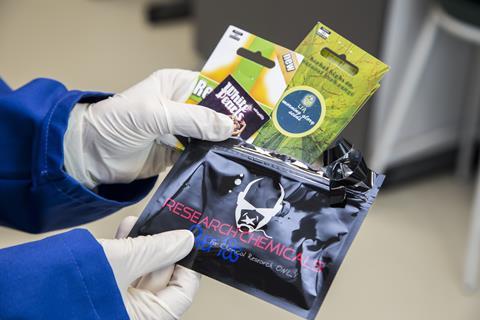
Nutt is therefore seeking to develop an alcohol replacement through a start-up company called Alcarelle. While the product will be a drink, its effects will be produced by an NPS. ‘We’ve got five candidates, several of which we’ve tested already,’ he says. ‘We’re close to a proper investors’ launch later this year.’ Rather than launching in the UK, where Nutt says ‘nobody knows whether it’s legal or not’, Alcarelle will likely initially target China.
Why won’t Alcarelle’s product cause undesirable behaviour and health effects like alcohol or spice? According to Nutt, ‘That’s where partial agonists come in.’ He emphasises that they’re more benign than full agonists, because they’re not turning the psychoactivity taps full-on. For example, Nutt previously helped develop buprenorphine, which he calls ‘a remarkably safe partial agonist’ for treating opiate dependence. He also cites another partial agonist, varenicline, as ‘the best anti-smoking agent’.
Nutt and Zee are right – some NPSs could be beneficial, and even profitable in a legitimate way. However, by using the PSA’s blanket prohibition to deal with the very real problems spice causes, the UK has made it harder to sort the good from the bad. Prohibition has arguably made the bad worse, in driving dealers towards more potent forms of spice, which can bring overdoses. More targeted action also struggles because it’s hard to identify rapidly changing, quickly broken down NPSs that are often taken in tiny amounts.
And many people regularly take drugs regardless of prohibition, Hamilton reminds us. He highlights the need for better information – not only about drugs’ negative aspects, but also their appeal. He thinks this is what countries like Portugal and the Netherlands have done well. ‘That’s a particular success, not through legislation, but through their approach,’ Hamilton says. ‘I think it’s been a much more adult way of communicating the ins and outs of drug use.’ Likewise, suggestions about rethinking prison drug testing regimes and steering people towards safer substances seem potentially useful.
The person behind the SC product ‘Pandora’s box’, referring to the Greek myth about unleashing trouble, may have been on to the reason why such steps are necessary. Academic SC developer John Huffman recalls having a similar realisation when he discovered that people were abusing his inventions. ‘I started hearing about some of the bad results, and I thought, “Hmm, I guess someone opened Pandora’s box.”,’ he told The Washington Post.
With the box open, economic laws reminiscent of the myth take over. John Maynard Keynes and Jean-Baptiste Say disagreed whether ‘supply creates its own demand’ or ‘demand creates its own supply’. Either way, today there’s a demand for people to alter their mental state, and a supply of spice, alcohol and other substances to do it with. They are all out of the box and show no signs of returning. For now, our hopes of reducing harm seemingly rest on whether we rise to the enormous challenge of finding more effective solutions than prohibition, or get stuck eternally playing whack-a-mole.
Andy Extance is a science writer based in Exeter, UK
References
1 S L Thornton et al,J. Med. Toxicol., 2012, 8, 310 (DOI: 10.1007/s13181-012-0232-4)
2 A J Adams et al,N. Engl. J. Med., 2017, 376, 235 (DOI: 10.1056/NEJMoa1610300)
3 J W Huffman et al,Bioorg. Med. Chem. Lett., 1994, 4, 563 (DOI: 10.1016/S0960-894X(01)80155-4)
4 R Lindigkeit et al,Forensic Sci. Int., 2009, 191, 58 (DOI: 10.1016/j.forsciint.2009.06.008)
5 J L Wiley et al, Neuropharmacology, 2016, 110, 143 (DOI: 10.1016/j.neuropharm.2016.07.016)
6 R Ralphs et al, Int. J. Drug Policy, 2017, 40, 57 (DOI: 10.1016/j.drugpo.2016.10.003)
7 E Wadsworth et al, Drugs Educ. Prev. Pol., 2017 DOI: 10.1080/09687637.2017.1284417
8 M Philp et al,Anal. Methods, 2013, 5, 5402 (DOI: 10.1039/c3ay40511g)
9 A Guirguis et al,Forensic Sci. Int., 2017, 273, 113 (DOI: 10.1016/j.forsciint.2017.01.027)
Additional information
If you want to know more about novel psychoactive substances these resources may be useful:
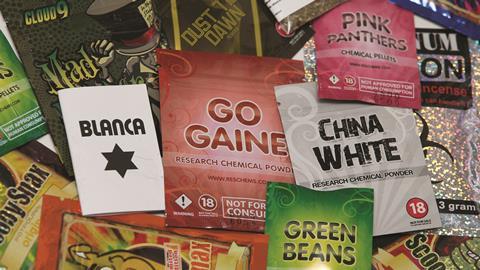
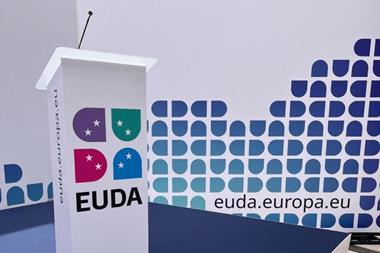
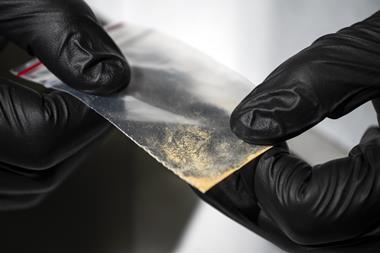

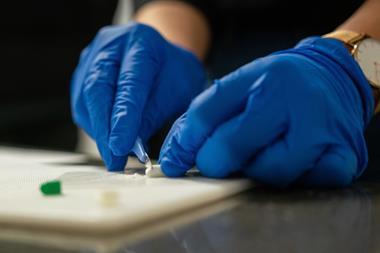
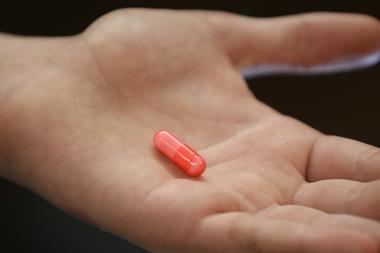
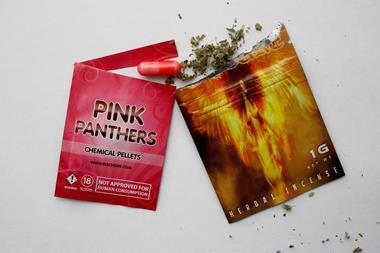






No comments yet